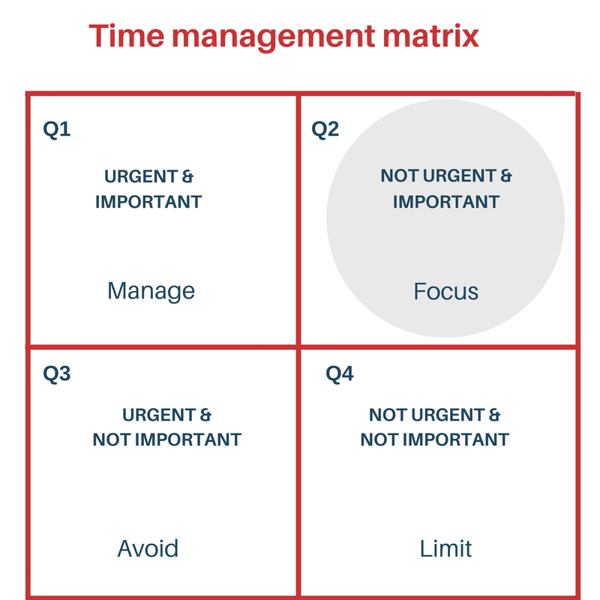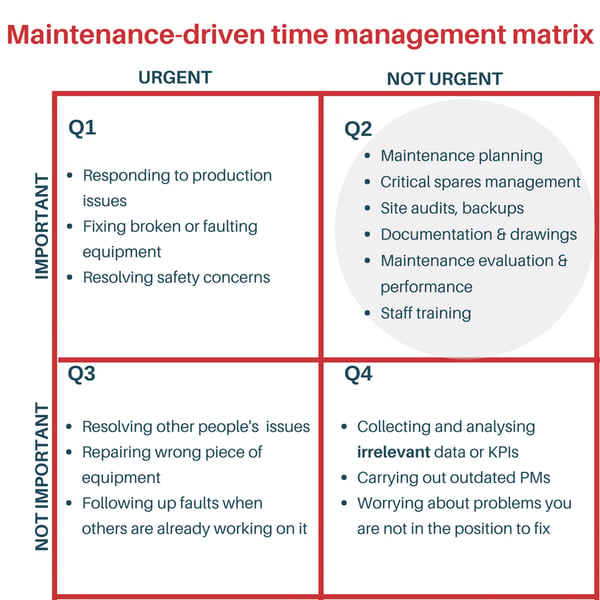What exactly is a Time Management Matrix and how can it prevent maintenance?
SAGE Automation, Published: May 4, 2018 - Updated: February 25, 2020 (6 min read)
Industrial operators widely recognize that preventative maintenance extends the life of assets, increases productivity, improves overall efficiency and reduces maintenance costs, with a significant margin on a run-to-failure maintenance approach..
But proper preventative maintenance is difficult to achieve, because it involves putting the seemingly non-urgent things before the fires that need to be fought in everyday production.
Today, we’ll take a look at a time-honoured tool in the business world,the Time Management Matrix, to show how it can help industrial operators move towards a preventative maintenance model. The good news is, It’s surprisingly simple.
What is the Time Management Matrix ?
The Time Management Matrix is a self-management tool, developed by Steven Covey in his infamous book, the 7 Habits of Highly Effective People.
It’s now widely used by business and individuals to prioritise the important tasks and identify time wasters. It classifies tasks into four quadrants:
Q1. Urgent and important.
The birth of your child, a customer complaint.
Q2. Not urgent, but important.
Your taxes, getting your car serviced, calling your mother.
Q3. Urgent, but not important.
Answering emails within 10 minutes of receiving them.
Q4. Neither urgent nor important.
A Netflix binge session, reading the comments in a news article.

A recreation of Steven Covey’s Time Management Matrix
I’m sure you can spot where you lose time in Q3 and Q4 in your own life, as well as at work.
The best-practice rule of thumb is to spend most of your time in Q2, followed by careful time spent in Q1. Stay away from quadrants 3 and 4!
The Time Management Matrix for manufacturing maintenance
In a manufacturing context, the quadrants might look like this:

Following the Time Management Matrix should lead you towards a preventative maintenance-based approach.
Q1 – Urgent and important. Responding to breakdowns, production issues or urgent safety concerns.
While downtime minimisation is central to any production goal, continuously devoting all of your time on Q1 activities will lead to burnout, stress, and lower profit margins through overall lost time in production.
Prevent these ‘fires’ by focusing on Q2 activities.
Q2 – Not urgent, but important. Training staff, maintenance scheduling and evaluation, or updating documentation.
These will have the highest pay off in the long term but will often get left off the daily task list because of their lack of urgency.
Aim to spend the majority of time in Q2.
Q3 – Urgent, but not important (to you or your goals). Interruptions and tending to other people’s urgent requests, repairing the wrong piece of equipment (misdiagnosing faults). You’d be surprised how often this happens! Another one is when multiple people chase up the same fault or problem instead of allocating it to one individual.
Set clear expectations around the timeframe in which you’ll respond to urgent requests and delegate tasks to clear out Q3.
Q4 – Neither urgent, nor important. Analysing the wrong metrics, worrying about things outside of your control or carrying out outdated preventative maintenance (PM) routines. The PMs carried out by the maintenance team should be under constant review to make sure resources are being effectively allocated.
e.g.
A spate of failures occur with equipment X. Management makes the decision to double the inspection frequency from every 6 months to every 3 months. Fast forward 5 years and equipment X output has halved due to production requirements. Therefore the wear on the equipment has halved. Is it an effective use of resources to still be inspecting this equipment every 3 months?
If you spend time in Q4, try to find ways to divert your attention to Q2. Often it is as simple as self-discipline!
What’s in your maintenance matrix?
Ask yourself how you fair when it comes to maintenance-based activities. Start by answering these questions:
- Think about where you spend most of your work day: Q1, Q2, Q3 or Q4?
- Now, draw a Time Management Matrix and log your time for the next 3 days in 30 minute increments. Were you right? Where do you spend the most time?
- Think of one activity or response you could change to shift more of your day-to-day into Q2.
- What communication, help, or tools do you need to make this a permanent change?
If you still can’t seem to move into Q2, consider the power of delegation or outsourcing. For example, a provider like SAGE Automation can help perform Q2 tasks such as critical spares management, updating documentation and CAD drawings or control system backups. Meanwhile, you can focus on planning and evaluating maintenance activities.
Moving into Q2 in an industrial maintenance setting will mean you’ll be closer to achieving preventative maintenance and reducing downtime. If you’re serious about preventative maintenance, read 7 actionable steps to move towards preventative maintenance.
Finally, when a breakdown does occur, which it will, arm your team with the tools to respond appropriately. Our Downtime Checklist was developed to help production staff troubleshoot breakdowns and prepare for the questions maintenance technicians will ask. This will free up your time and empower employees to make the right decisions to get you back up and running quickly.
You can download and hand out the free Breakdown Checklist here.
SAGE Automation delivers agile, scalable and secure solutions that don’t just solve current problems, they preempt and deter future ones, helping your organisation thrive. With years of experience working in defence, infrastructure, resources, utilities and manufacturing we have the expertise you need to custom-build or perform manufacturing maintenance on your equipment for maximum ROI.









